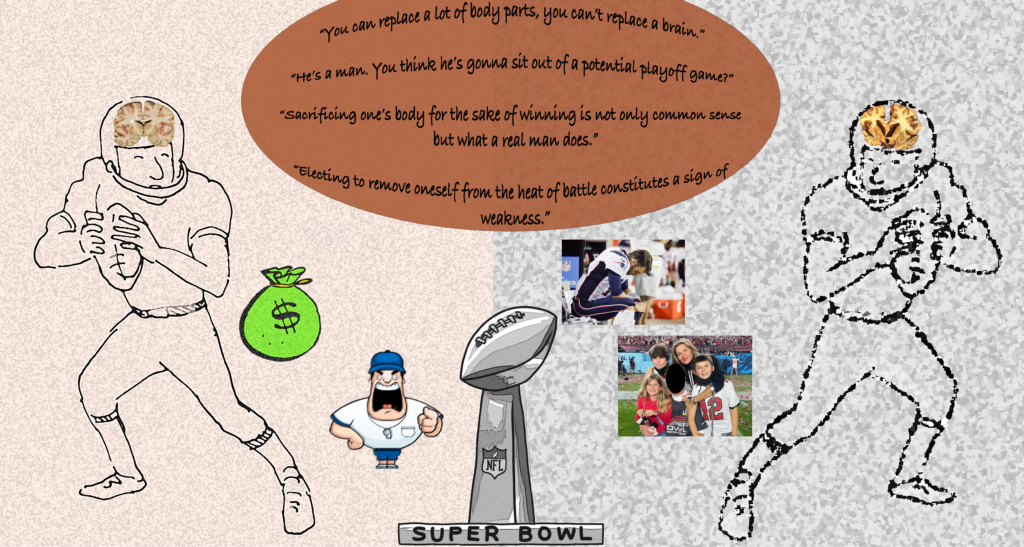
Chronic traumatic encephalopathy (CTE) is the long-term neurologic consequences caused by repetitive concussive and subconcussive blows to the brain (Omalu et al. 2010). “99% of the National Football League (NFL) players’ brains showed signs of neurodegenerative disease when autopsied” (Smith 2021: pg 3492). This deadly disease was first discovered in 2002 in the brain of Mike Webster, a deceased member of the Pittsburgh Steelers of the NFL (Abreu et al. 2016).
Miami Dolphins quarterback, Tua Tagavailoa, was allowed to return to this game after receiving this vicious hit shown in the above video clip. In the following game, he received a similar hit and was carted off on a stretcher. The Dolphins then reported that Tagavailoa sustained a concussion (Benson et al. 2022). This event depicts a serious issue within the NFL. The cognitive health of these athletes is less important than the team’s success.
This pressure stems from management of NFL organizations relying on their star players to bring success to the franchise, which drives up merchandise and ticket sales. Playing through these injuries leads to a life of memory loss, mood swings, increased aggression, and many other detrimental effects (Siegel 2019).
Playing through Injury
Why would an athlete, who suspects that he may be concussed, not remove himself from the game? In football, a stigma of exiting during the heat of competition has long existed (Siegel 2019). In the New England Patriots organization, all players are expected to follow the standards of their organizational culture the – “Patriot Way” -demanding that players put the team ahead of themselves (Siegel 2019). In an interview with Gisele Bundchen, Tom Brady’s ex-wife, she discusses how even though her husband has had concussions, “they don’t talk about it” (Siegel 2019: pg 551). The ability to gain more autonomy over decisions regarding head injuries may have been part of his shocking decision to leave the New England Patriots and join the Tampa Bay Buccaneers (Siegel 2019).
How Concussions Effect Performance
The short-term outcomes of severe concussion are
- Severe concussions result in reduced career length, decreased performance on the field, and unfavorable financial outcomes.
- Average decline in salary at $300,000 per year.
- Chances of continuing a career in the NFL for the following five years after injury was 11.6%, in comparison to non-concussed players odds of 36.6%.
- Within the first year of their concussion, their release rate from organizations increase by 12% when examining concussed athletes versus non concussed.
- Chances of retiring increased by 13.4% during this same 1 year time period (Navarro et al. 2017).
Life after Football
In order to fully understand this issue in the NFL, it is important to look at the aftermath of these athletes’ careers. Football promises fame and glory through a sport encouraging male aggression and virility which, conversely can inflict a significant physical toll on the athlete’s body (Siegel 2019). There’s evidence of an increased chance of depression and dementia within retired NFL players who experienced concussions, compared to their counterparts (Navarro et al. 2017). The sporadic characteristics of these retired athletes can make it difficult for their family members to truly comprehend the emotional and physical pain of what they are going through (Smith et al. 2021).
The Tua Tagovailo injury exemplifies how the NFL fails to handle head related injuries. Concussions and the lasting results of brain trauma are deep-rooted problems in the NFL, and the best way to tackle this issue is for the league to intervene with solutions to continue to improve player safety.
Works Cited
Abreu, Marcos A., Spradley D. Brandon, and Cromartie, Fred J. . 2016. “Chronic Traumatic Encephalopathy (CTE) and Former National Football League Player Suicides.” The Sport Journal. Retrieved December 2, 2022 (https://thesportjournal.org/article/chronic-traumatic-encephalopathy-cte-and-former-national-football-league-player-suicides/).
Anon. 2022. “Tua Tagovailoa Injury after Hitting Head vs. Bills.” YouTube. Retrieved November 28, 2022 (https://www.youtube.com/watch?v=d5c_zR85ca4).
Belson, Ken, Jenny Vrentas, and Emmanuel Morgan. 2022. “Doctor Who Examined Tagovailoa Is Dismissed; N.F.L. Assessing Concussion Rules.” The New York Times. Retrieved December 4, 2022 (https://www.nytimes.com/2022/10/01/sports/football/tua-tagovailoa-doctor-fired.html).
Navarro, Sergio M., Olumide F. Sokunbi, Heather S. Haeberle, S. Schickendantz Mark, Michael A. Mont, Richard A. Figler and Prem N. Ramkumar. 2017. “Short-Term Outcomes Following Concussion in the NFL: A Study of Player Longevity, Performance, and Financial Loss.” Orthopaedic Journal of Sports Medicine 5(11). Retrieved September 29, 2022 (https://doi.org/10.1177/2325967117740847).
Omalu, Bennet I., Ronald L. Hamilton, Ilyas M. Kamboh, Steven T. DeKosky, and Julian Bailes. 2010. “Chronic Traumatic Encephalopathy (CTE) In A National Football League Player.” Journal of Forensic Nursing 6(1):40-46. Retrieved October 16, 2022 (https://doi.org/10.1111/j.1939-3938.2009.01064.x).
Siegel, Brett. 2019. “Concussions and Capital: Tom Brady, CTE, and the NFL’s Crisis of Identity.” Journal of Sport and Social Issues 43(6):551-574. Retrieved September 29, 2022 (https://doi.org/10.1177/0193723519868192).
Smith, Matthew J., Georgia Young, John Batten, Keith D. Parry and Rosie Collins. 2021. “Athletes with Neurodegenerative Disease: A Phenomenological Exploration of Family Members’ Experiences.” The Qualitative Report 26(11):3492-3518,3492A-3492B. Retrieved September 29, 2022 (https://doi.org/10.46743/2160-3715/2021.4899).